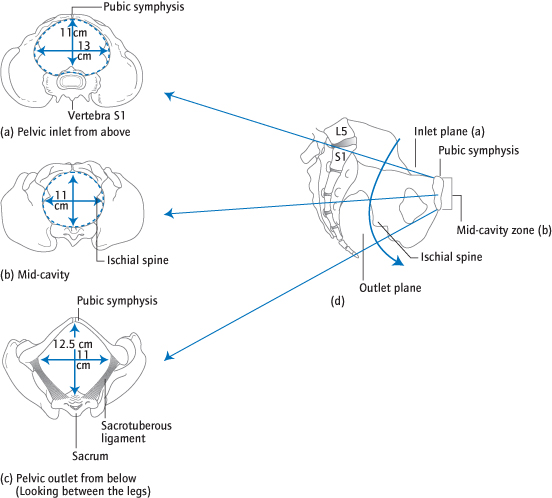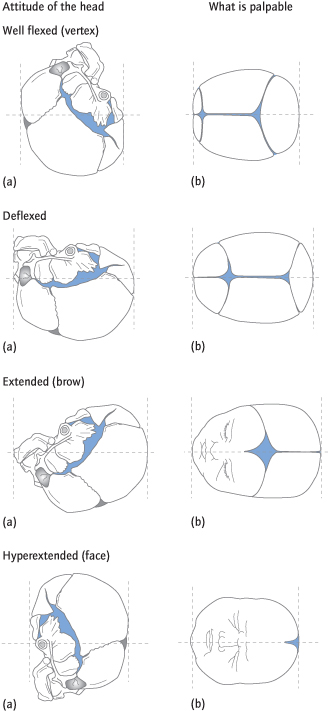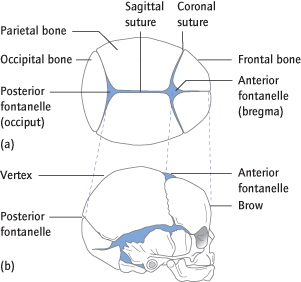The Passage
The Bony Pelvis
This has three principal planes. At its inlet, the transverse diameter is about 13 cm, wider than the 11-cm antero-posterior (AP) diameter (Fig. 28.2). The mid-cavity is almost round as the transverse and AP diameters are similar. At the outlet, the AP diameter (12.5 cm) is greater than the transverse diameter (11 cm). In the lateral wall of the round mid-pelvis, bony prominences called ischial spines are palpable vaginally. These are used as landmarks by which to assess the descent of the head on vaginal examination: the level of descent is called ‘station’ and is crudely measured in centimetres in relation to these ‘spines’. Station 0 means the head is at the level of these spines; station +2 means it is 2 cm below and station −2 means it is 2 cm above (Fig. 28.3). A variety of pelvic shapes have been described, but diagnosis and therefore description of these is seldom useful in clinical practice.
Fig. 28.2 Anatomy of the pelvis showing the three planes (a, b and c), and where they are on a lateral view of the pelvis (d).

The Soft Tissues
Cervical dilatation is a prerequisite for delivery and is dependent on contractions, the pressure of the fetal head on the cervix and the ability of the cervix to soften and allow distension. The soft tissues of the vagina and perineum need to be overcome in the second stage: the perineum often tears or is cut (episiotomy) to allow the head to deliver.
The Passenger
The head is oblong in transverse section. Its bones are not yet fused and, on vaginal examination, spaces between them are palpable as sutures and fontanelles. The anterior fontanelle (bregma) lies above the forehead. The posterior fontanelle (occiput) lies on the back of the top of the head. Between these two is the area called the vertex. In front of the bregma is the brow (Fig. 28.4). Because the head is not round, several factors determine how easily it fits through the pelvic diameters.
Attitude: Extension/Flexion
The attitude is the degree of flexion of the head on the neck (Fig. 28.5). The ideal attitude is maximal flexion, keeping the head bowed. This is called vertex presentation, and the presenting diameter is 9.5 cm, running from the anterior fontanelle to below the occiput at the back of the head. A small degree of extension results in a larger diameter. Extension of 90° causes a brow presentation, and a much larger diameter of 13 cm. A further 30° of extension (with the face looking parallel and away from the body) is a face presentation. Extension of the head can mean that the fetal diameters are too large to deliver vaginally.
Fig. 28.5 Attitude of the fetal head showing how extension of the head changes the presenting diameter and what is palpable on vaginal examination.

Position: Rotation
The position is the degree of rotation of the head on the neck (Fig. 28.6). If the sagittal suture is transverse, the oblong head will fit the pelvic inlet best. But at the outlet the sagittal suture must be vertical for the head to fit. The head must therefore normally rotate 90° during labour. It is usually delivered with the occiput anterior (occipito-anterior [OA]). In 5% of deliveries it is occipito-posterior (OP) and more difficulty may be encountered. Persistence of the occipito-transverse (OT) position implies non-rotation and delivery without assistance is impossible.
Stay updated, free articles. Join our Telegram channel

Full access? Get Clinical Tree




